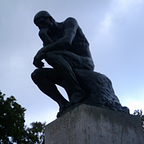Characters of the Net, Unite!
Futures Of Text Through
The Looking Glass Of Tailorability
Part 1 of 5
Introduction.
I’ve spent a lot of my professional life fascinated by text and have been influenced by many people and projects.
Last month I attended the World Financial Symposium (WFS) hosted by Corum in Seattle and listened to investors and fellow CEOs confer about the future of computing. On the train back to Portland, I read Futures of Text by Jonathan Libov. That article inspired me to corral my thoughts about the futures of text by reflecting back on the history of text communication systems. Gazing into the past, I’ve recounted a few text-based applications in their historical context, their current state, and how they might evolve as futures of text.
Notwithstanding decades of innovation, I believe there are still many
“think big ideas” (an expression Bill Bryant used at WFS) and predict more startup unicorns will rise from text/messaging.
Moreover, I hope some of these ideas come to fruition because they improve empathy, engagement, and expression. Nurtured by caring hearts and hands, they become Committed Technology and improve world peace through shared learning.
Back To The Future.
My love for text goes way back.
To the early 90s and the Stanford Computer Science library. I was not a Stanford student (I’m an Oregon graduate. Go Ducks!) but was living in San Francisco. One of my favorite activities was driving to Palo Alto and spending the afternoon reading at the Stanford CS library. At the time, you could just walk in, student or not, and browse shelves of technical books and journals. After a couple of visits, it was clear the most innovative literature about computing was bound up in blue and white technical reports published by Xerox Palo Alto Research Center (PARC).
This was a prehistoric time before all literature, especially scientific journals, was digitized. A time of paper! Each page from those thin bound pamphlets was a treasure map laying out current research discoveries and project citations from decades earlier. Projects like Sketchpad (1963), GRAIL (1966), Doug Engelbart’s mother of all demos NLS (1968), Alan Kay’s Dynabook (1972), Xerox Alto (1973), and Hypercard (1987).
Turning each page was like unfolding a map of the future.
Those blue and white pamphlets were gold bullion from the hallowed halls of Xerox PARC just down the road at 3333 Coyote Hill.
The research that inspired me most were projects about text.
I was instantly hooked when I read Notecards (1984) a Lisp-based hypertext system.
NoteCards and hypertext projects like Intermedia and Neptune (from Tektronix in my hometown of Beaverton, OR) introduced me to Vannevar Bush’s Memex vision. They explored how ideas could be formed and shared by connecting electronic documents with typed links. They molded the Web and browsers (Mosaic 1994). They spawned Lotus Notes and the bygone groupware category revived in modern parlance as enterprise social networking.
What captivated me about these seminal hypertext systems was their commitment to empowering users.
In Reflections on NoteCards: seven issues for the next generation of hypermedia systems (1987) Frank Halasz co-investigator on NoteCards laid out seven issues that future hypermedia systems would need to solve. Issues of search, composability, materialized views, programmability, versioning, and collaboration. The last issue, tailorability, captured my imagination:
“Despite its success, the NoteCards programmer’s interface failed to meet one of its explicit design goals: that minor changes to NoteCards should be achievable with a small amount of work by casual, nonprogramming users. In its current form, the programmer’s interface provides significant functionality only to those who have a fair degree of expertise in programming and system implementation. Unfortunately, this is true of the tailoring interfaces in most of the current generation of hypermedia systems as well. The challenge, then, is to design mechanisms for the small tailorability of hypermedia systems.”
The Magic of Tailorability.
The challenge of tailorability is a call-to-action that conjures up the romance of personal computing so eloquently articulated — and lamented for its loss — by the PARC pioneer, Turing award winner, and extraordinary raconteur Alan Kay. Simple tools that empower creativity are magical.
Many decades later, text remains an interface ripe for tailorability. As a means for defining and expressing language, text has the special province to empower people to both read and write. To learn and share. Text works across cultures, classes, and devices. Text can be modified effortlessly with one tap, one keystroke. Text enables knowledge discovery and creation giving “casual, nonprogramming users” an immanently tailorable tool for browsing and authoring.
For all media, the original intent was “symmetric authoring and consuming” — Alan Kay
Reflecting on the past and current state of text through a looking glass of tailorability magnifies clues about the futures of text. With so much innovation over so many decades, it’s hard to isolate the few, most influential projects. Especially when any single innovation derives from many interconnected ideas. As a woefully abridged tour of the past, current, and futures of text, I’ve chosen four primordial text applications that embody different facets of tailorability.
IMHO, these applications will continue to be rediscovered and reinvented by modern programmers, inspiring startups to extend tailorability motifs on state-of-the-art technology platforms — from smartphones and smartboards to wearables and watches to game consoles and the Internet of Things.
We will ride these protean applications as unicycles for the mind, self-propelled as learners and creators, onward into the futures of text.
This article continues in four more parts:
Part 2: Hypertext as Semantic Tailorability
Part 3: Spatial Hypertext as Contextual Tailorability
Part 4: IRC as Collaborative Tailorability
Part 5: BBS as Programmatic Tailorability
Thanks to all the people I mention (and those that I neglect to mention) for their genius, humility, and inspiration.
With Gassho!
Russell Okamoto
A Public Cellyzen
